
Previous Automation Builder
Wix Automations: Creating a New Automation
This article refers to the previous automation builder. If you're not seeing this version, read our article about the new version of the automation builder.
Create a new automation based on the way you'd like to grow or manage your business. Choose to create one from scratch or make edits to a suggested automation. When you begin to create an automation, you'll see suggested automations specific to your business type.
All automations consist of a trigger and an action. An automation's trigger is the event that causes the action to occur. The action is the response to the trigger.
An important factor of an automation is the timing. As the action occurs automatically, the timing needs to be set in advance. The action can take place immediately after the trigger, or after a predefined number of hours or days.
Example:
Joan has a monthly newsletter. She creates a newsletter subscription form to grow her mailing list. She wants to thank each subscriber as they sign up, but manually sending these emails would be impossible. Instead, she sets up an automation that automatically sends a 'thank you' message every time a new person subscribes.

Step 1 | Add a new automation
Any automations you create appear in Automations in your site's dashboard. Make sure to choose a name that's memorable and can be understood by all of your site collaborators.
To add a new automation:
Go to Automations in your site's dashboard.
Click + New Automation at the top right.
Choose how you want to start creating your automation:From Scratch: Click Start from Scratch to begin from a blank automation template.
Suggested automation: Use the categories or search bar to find the suggested automation you want to edit. Then click Set Up next to the automation.
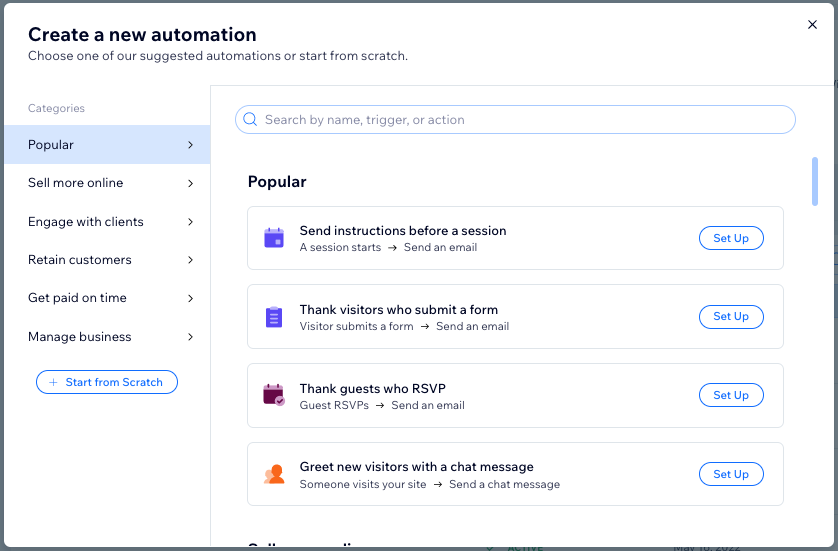
Click the title to give your automation a name.
Step 2 | Choose a trigger
The trigger is the action or event that initiates the automatic response. This may be something that a visitor does on your site (for example, purchasing a product), or something you do (for example, creating an invoice).
The triggers you'll see listed differ depending on the app you're using (for example, Wix Forms, Wix Stores). Choose the app and then select one of the available triggers.
To choose a trigger:
Click the app you'd like to base your trigger on in the Trigger section.

Select your chosen trigger from the available options.
Note: These options will differ depending on the app you selected in step 1.
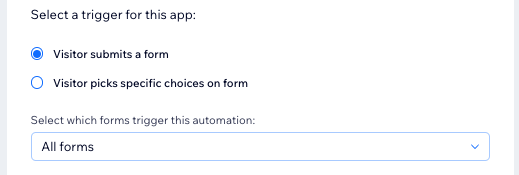
Click the Limit frequency to drop-down to set trigger frequency:Don't limit (trigger every time): Your action will take place every time it is triggered by a visitor.
Once per contact: Your action will take place only once per contact.
Once per contact every 24hrs: Your action will take place only once per contact in any 24hr period.
Step 3 | (Optional) Add a delay
Choose when this action should occur. You may want to perform the action immediately after the trigger occurs or set a delay to send it after a certain amount of time has passed. For example, if your trigger is "Customer abandons a cart" and your action is "Send an email", you would probably want this to be sent after a certain amount of time has passed.
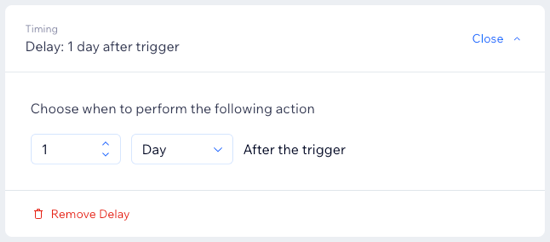
To add a delay to your automation:
Click + Add Delay.
Click the up and down arrows to set the number and click the drop-down to choose between days, hours and minutes.
Note:
If you don't add a delay, the action is performed as soon as the trigger occurs.
Step 4 | (Optional) Add a condition
After choosing a trigger, you have the option to add a condition. Conditions allow you to set and manage complex automation flows.
For example, you use Wix Restaurants and have introduced a new sharing menu for tables of 4 guests and over. You'd like to send an email update to all customers who have made such bookings. By creating an email automation with the condition that a reservation is for a party size greater than 3, you're targeting this group of customers and not customers who have booked tables for smaller groups.
To add a condition:
Click + Add Condition.
Click the Select criteria drop-down and choose the criteria you want to use to decide whether this automation continues each time it's triggered.
Click the drop-down that appears next to your criteria drop-down to select your operator (e.g. "is", "is not").
Click the drop-down or text box that appears next to your operator drop-down to complete your condition. The logical statement you've created will determine whether the automation continues.
(Optional) Click + Add Criteria to add any further criteria.
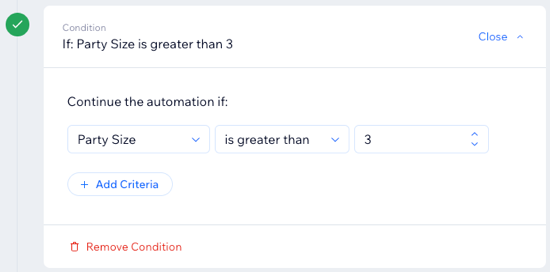
Tip:
Learn more about condition operators.
Step 5 | Choose an action
After choosing a trigger, decide how you want your site to react to that trigger. For example, if your trigger was 'Visitor submits a form on your site', you might want to send that visitor an automatic thank you email. Wix Automations offers several actions, each of which can be customized to suit your needs.
To choose an action:
Click your chosen action in the Action section.
Note: The actions available will differ based on your trigger choice.
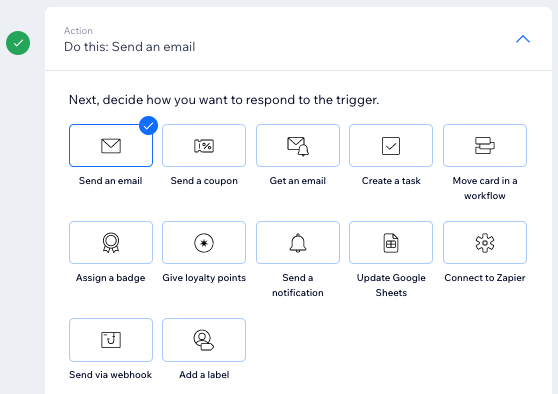
Set up the action using the available options. Click the relevant action below to learn how:
Send an email
Click Edit in the Sender details section to edit your sender details:From name: This is the name that appears in the recipient's inbox.
Reply-to email: This is the address that replies are sent to.

Scroll down to the Create an email section and choose what you want to do:Click Edit to update the default template generated by this automation.
Click the More Actions drop-down and select Switch template to use an email template from a different automation or email marketing campaign.

Tips:
Learn more about customizing automated emails, including editing sender details, designing email templates and using dynamic values to give your emails a personal touch.
If you want to send emails to yourself and your team, deselect the Include trigger contact checkbox and select all contacts or roles who you want to receive the email.
Make sure to create email automations that don't overlap with other emails. Many apps already send emails to your contacts for specific events (e.g. making purchases in Wix Stores).
Send a chat message
Enter the chat message you'd like to send in the Message field.
Click the Send this message only when I'm online to chat toggle to specify when these messages are sent:Enabled: This chat message will only be sent when your chat status is online.
Disabled: This chat message will be sent whether your chat status is online or offline.

Notes:
You must have installed Wix Chat to set up this action.
By default, chat messages are sent immediately after trigger. It is not possible to change the timing.
Add a coupon
Select whether to send a unique coupon each time in the Set Coupon section.
Click the Select or create a coupon template drop-down to choose the coupon you want to use or create a new one.

Adding a coupon does not automatically send that coupon to visitors. You need to attach the coupon to an app and add it as a dynamic value to send. Learn more about adding coupons.
Send an SMS
If you are subscribed to a Wix Business Phone Number plan, you can send SMS messages to contacts who have provided cell phone numbers. Learn more about sending automated SMS messages.
Create a task
Add a task for yourself or your team members and set a due date for it.
Enter your task in the Add a task for you or your team field.
Click the Assign to you or your team drop-down to choose to have the task sent to you or a member of your team, or left unassigned.
Click the Set a due date toggle to choose whether to set a due date:Enabled: Select a value in the Number of days to complete task field.
Disabled: Your task will not have a due date.

Learn more about tasks and reminders.
Move card in a workflow
A workflow is a list that displays all of the steps of a project in columns so you can easily keep track of every phase. Create or move a card in a workflow automatically with Automations.
Learn more about workflows.
Click the In This Workflow drop-down to select the workflow you'd like to move a card in.
Click the To This Step drop-down to select the step you'd like to move the card to.

Assign a badge
Badges allow you to label your contacts so they can be easily differentiated (for example, a badge could mark a certain milestone being met). Learn more about badges.
Click x beside the badge(s) you don't want to assign, until you can only see the badge(s) you do want this automation to assign.

Note: Click + Add Badge to create your first badge if you don't see any listed.
Give loyalty points
Reward your visitors for their loyalty by assigning loyalty points. Learn more about the Wix Loyalty Program.
Enter a description of this way of earning points in the Tell customers how they can earn points field.
Note: This description should reflect the trigger you've chosen for this automation (for example, if your trigger is a visitor submitting a form, this will be the way they earn points).Enter the number of points awarded in the Customer earns field.

Note: You can also add ways to earn loyalty points within the Loyalty Program area of your site's dashboard.
Update Google Sheets
Send site data, such as form submissions or store orders, directly to a Google spreadsheet. Learn more about using automations to send data to Google Sheets.
Connect to Zapier
Connect your automations to more than 1,000 apps like Google Docs, Trello, Slack and more. To use this feature, you'll need to enable Velo and sign up to Zapier. Learn more about connecting your automations with a third-party app using Zapier.
Send via webhook
Send data to a third-party app or your own server using a webhook. Learn more about automatically sending data using a webhook.
Add a label
Adding labels to your contacts helps you to filter your contact list and categorize your mailing lists. Learn more about labels.
Click + Add Label to select the label(s) you'd like to add.

Send a push notification
Send a push notification that appears on a customer's device screen ("pushed" by their mobile app). Enter the notification's title and message, and choose whether it takes customers to your app's home screen or a specific product or service.
Notes:
This action is only available with a Mobile App Premium plan and when your app is live in stores.
We are currently in the process of releasing this functionality, so this action is not available for all triggers yet. If you select a trigger and see the Send a push notification action, it is available for that trigger.
Invite to a group
Send an email to contacts to invite them to join your group.
Select an existing group you want to invite contacts to, or create a new group.
Want to create a follow-up action?
Add a chain of follow-up actions from the initial action.
Step 6 | Activate the automation
Click Activate to save and activate the automation. It now appears on your Automations page where you can edit, deactivate or delete according to your needs.
